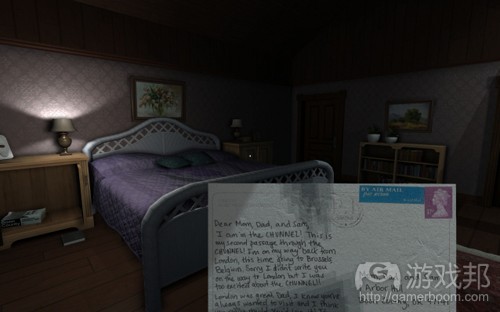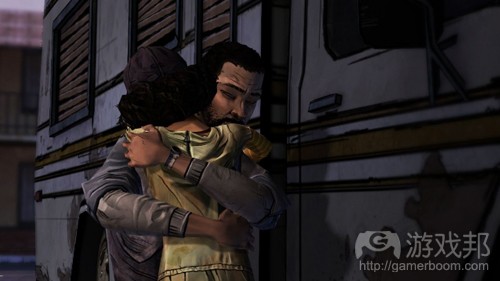开发者应重视“小型”游戏设计体验
作者:Matt Girdler
许多AAA开发者似乎在通过制作市场上最大,最高调的游戏(如更大的爆炸效果,更大的预算)而相互较劲。而游戏作为一种媒体,当然能够有效提供这种大型体验,它们还能够提供更为人性化的体验,但不幸的是多数开发者没有很好地发掘这个机会。
创造一款小型游戏时,可以将那些只是作为摆设的大型而开放的场景换为更小,但是充满视觉细节和玩家可交互对象的小型游戏世界,以便让玩家真正融入游戏体验中。
以我去年最喜欢的游戏之一《Gone Home》为例。它是一款故事探索游戏,其背景是一个完全真实的家庭,玩家可以查看和操纵自己在房子里找到的任何物品。在游戏中,你要扮演Kaitlin这名在1995年回家的20岁年轻人,但却发现家中所有人都凭空消失了,你必须侦察整个房子,找到其中发生了什么情况。通常将游戏背景置于一个小家庭中,开发者就需要考虑玩家的交互行为,以便令游戏过程变得有趣。它还通过提供玩家在自己日常生活中所熟悉的活动和场景,创造了一种沉浸感。
当然,《Gone Home》并非一款AAA作品,甚至也算不上是动作游戏,但这并不意味着其设计原则不适用于这两种类型的游戏。为了进行对比,我们以经典动作电影《虎胆龙威》为例进行分析。提到《虎胆龙威》我最先想到的是John McClane光脚在炮火声打破出口,在满地玻璃碎片的路上奔跑并因此完成割伤双脚的场景。为此,McClane在电影其余部分中都不得不带伤出现。这是一个在人性层面深深影响主角的时刻,令观众不禁更同情他的脚伤而非枪伤,毕竟多数人都没有遭遇过枪伤,而对玻璃割伤更为感同身受。
我们不难想出含有类似场景的游戏。游戏的目标并非杀死无数恐怖分子,而是生存下去。玩家要使用在关卡中找到的破布作为临时绷带来止血。研究地面路线图以便找到最佳目标路线,只是偶尔才需要干掉几个敌人。这不但解决了普通主角会瞬间变成杀人机器这种不协调的问题,还可以让玩家因主角的脆弱和相关状态而更好地融入对方的情境。
我们可以理解为何这种设计方法并不常见,因为它要求程序员创造更复杂的系统,迫使设计师发挥更大创意,无法简单地在不同的异域场景中重复相同的敌人遭遇战。在更小的场景中创造游戏背景的一个好处在于,它减少了所需的美术资产,有可能节省潜在的开发成本。
也许最重要的事情就是在游戏世界中创造一致性的地方感。我已经不记得有多少次在探索一个场景时因为遇到一堵隐形墙而被迫中止,或者试图爬上楼梯而始终不得要领(尽管我在游戏早期已经多次爬上了相同的楼梯)的情况了。这种时刻只会提醒我游戏只是一个过山车,我只是一个被带动的乘客。
场景中的交互性也是创造富有真实感世界的一个关键。有时候我发现只是简单地要求玩家打开一盏灯以便查看暗室的情况,或者将椅子移到某一位置并站在其上够着高架上的某物,这种小小的时刻就能够创造沉浸感了。
现在已经出现了开发者尝试采用这种设计原理的迹象了:Telltale的《行尸走肉》表明专注于人类互动的小型游戏也能够非常成功,并且名利双收。Irrational Games创意总监Ken Levine最近宣布其工作室将关闭,Levine和将近15名前Irrational成员组建了一家新工作室。这个小型新团队将专注于制作“面向硬核玩家、极具重玩性的故事导向型游戏”。有如此多杰出的人才因此而失业着实令人遗憾,但我个人却乐见这些《生化奇兵》背后的精英去做自己的小型项目。
这种小型设计方法不仅能够减少潜在开发成本,还可以创造一种玩家能够施加影响,以及被自己周围的环境所感染的游戏,令游戏产生大于各个部分之和的效果。这将成为一个让玩家进入就沉陷其中的新世界。(本文为游戏邦/gamerboom.com编译,拒绝任何不保留版权的转载,如需转载请联系:游戏邦)
Game Design – Is It Time to Downsize?
Matt Girdler
Many AAA developers seem to be trying to one up each other by making the biggest, most bombastic game on the market. Bigger set pieces; bigger explosions; bigger budget. While games, as a medium, are certainly effective at providing these large scale experiences, they are also good at providing experiences on a more human scale, an approach that unfortunately goes un-utilised by most developers.
When creating a game on a small scale, large and open environments that exist purely as set dressing for the action can be exchanged for smaller game worlds, packed with visual details and objects that the player can interact with in a way that feels real and truly draws the player into the experience.
Take Gone Home -one of my favourite games of last year – for example. For those who don’t know, Gone Home is a story exploration game set entirely inside a fully-realised family home in which the player can examine and manipulate anything they find in the house. In the game you play as Kaitlin, a 20 year old who returns home in 1995 to find that everyone is missing; you must investigate the house and discover what happened there. By setting the game in a small family home the developers were forced to think of original interactions for the player to keep things interesting; it also created a sense of immersion by providing activities and scenes that players are familiar with from their everyday lives.
Of course, Gone Home isn’t a AAA title or even an action game, but that doesn’t mean the same design philosophy can’t be applied to a game that is both. To compare, for a moment, the sort of scale I’m talking about with films, just look at the classic action flick Die Hard. When I think of Die Hard the first moment I am reminded of is the scene where John McClane, barefoot and under gunfire, has to break for the exit, running on the shattered glass and cutting up his feet in the process. As a result, McClane is left with an injury that he must cope with for the rest of the movie. This is a moment that affects the protagonist on a very human level, one where the audience can sympathise with his pain, more so than a bullet wound, which most people will (hopefully) have no frame of reference for.
It’s not hard to picture a game that incorporates moments like this. A game where instead of killing countless terrorists, your objective is only to survive. The player would make use of rags found in the levels as makeshift bandages to stop wounds from bleeding, study floor plans for the best route to your objective, and kill enemies on only a few occasions. Not only would this solve some of the disconnect that occurs when wisecracking, everyman protagonists become ruthless killing machines *cough*Nathan Drake*cough*, it also allows the player to better engage with the protagonist due to his more vulnerable and relatable state.
It’s somewhat understandable that this design approach is not used more often, as it requires the programmers to create more complex systems, and it forces the designers to be more creative when they can’t simply repeat the same enemy encounters in different exotic locales. An upside of developing a game set in a smaller location is that it reduces the amount of art assets required, potentially saving on development cost.
Perhaps the most important thing to creating a sense of place in the game world is consistency. I can’t count how many times I’ve been exploring an environment only to stop dead in my tracks due to an invisible wall, or attempting to climb a ladder to no avail, despite having done so multiple times on identical ladders earlier on in the game. Moments like these only serve to remind me that the game is a rollercoaster and I’m just a passenger, along for the ride.
Interactivity in the environment is also key to creating an authentic-feeling world. Sometimes I’ve found immersion can be provided by small moments as simple as requiring the player to turn on a light in order to see in a darkened room, or having to move a chair into position and standing on it to reach an object on a high shelf.
There are signs of developers attempting to adopt this type of philosophy; Telltale’s The Walking Dead proved that smaller titles focusing on human interaction can be very successful, critically and commercially. More recently, Irrational Games’ creative director, Ken Levine, announced that the studio would be closing its doors, with Levine and roughly 15 ex-Irrational staff members forming a new studio. The new, much smaller team will be focusing on making “narrative-driven games for the core gamer that are highly replayable.” Obviously it’s a shame that so many talented people lost their job due to this move, but, personally, I’m very excited to see what the minds behind BioShock will do with their new small-scale attitude.
Not only could a small-scale approach potentially reduce development costs, but by creating a game in which the player can affect, and be affected by, their surroundings on a human scale, a game can become more than the sum of its parts. It can become a new world for the player to step into and lose themselves in. Failing that, you can always add more explosions.(source:gamegrin)
上一篇:分享开发者创造定制音频的6个建议









































 闽公网安备35020302001549号
闽公网安备35020302001549号